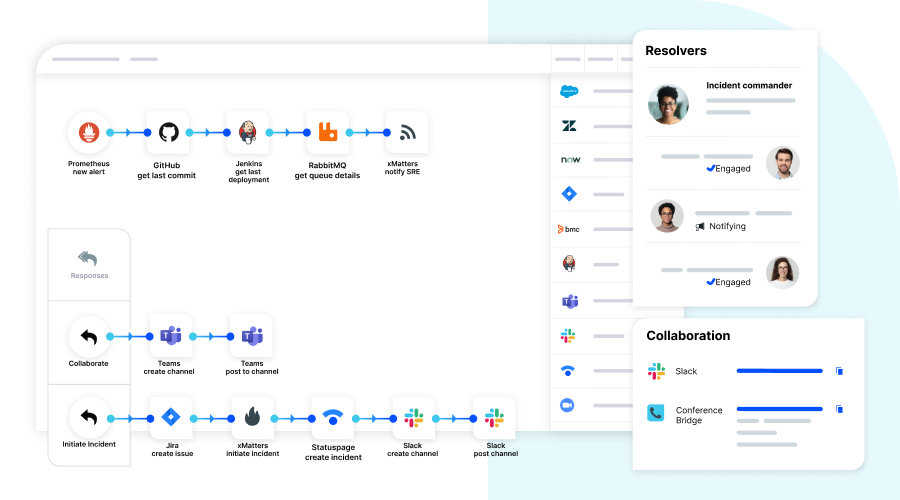Evaluating PagerDuty Alternatives

When it comes to incident management tools, PagerDuty often dominates the conversation, but that doesn’t mean it’s always the right fit for your organization. Whether you’re scaling quickly, managing complex workflows, or simply need features that better suit your team’s style of work, exploring PagerDuty alternatives can open doors to more tailored and effective solutions.
If you’re one of the many IT professionals, DevOps teams, or SREs evaluating whether PagerDuty’s offerings align with your needs, this blog will provide you with a comprehensive comparison of alternatives and explain why tools like Everbridge xMatters, Atlassian, and Datadog are being chosen by forward-looking organizations.
Why Consider PagerDuty Alternatives?
PagerDuty is well-regarded as an all-in-one incident management tool. However, customers often find themselves facing challenges with its scalability, growing cost, and limited customization options.
Here are some common reasons we’ve heard from enterprises seeking out alternatives:
- Cost-Intensive Extras: PagerDuty’s advanced features often come as expensive add-ons, quickly inflating the total cost of ownership.
- Redundancy & Complexity: Logging into multiple tools and accessing fragmented systems makes it challenging for teams to maintain an efficient workflow.
- Limited Scalability: Many users report challenges as their organization’s scale, particularly when managing enterprise-level complexity.
- Additional Tools Required: While PagerDuty offers incident management, it often cannot meet modern needs for collaborative workflows or seamless integrations.
Now, let’s explore some of the best alternatives businesses like Sony Interactive Entertainment and others are turning to.
Top PagerDuty Alternatives
Here’s a roundup of some of the most notable incident management tools, focusing on how they compare to PagerDuty and help solve challenges in areas like scalability, cost, and flexibility.
1. Everbridge xMatters

Why Choose xMatters?
xMatters is an incident management platform designed to automate workflows, connect critical systems, and streamline incident resolutions. Where PagerDuty can feel rigid and siloed, xMatters offers unparalleled flexibility with tools like Flow Designer, which enables users to build automated, no-code workflows tailored to their teams.
Key Features of xMatters:
- Native Process Automation: Seamlessly automate issue remediation from detection to resolution with integrated solutions. xMatters connects to existing tools, such as Slack, Jira, AWS, and many more, through pre-built integrations and open APIs.
- Service Intelligence: Provide insights and automate next steps, integrating real-time analytics into incident management processes with Purpose-built AI. This enables actionable insights that proactively inform teams of service dependencies and potential impacts.
- Signal Enrichment: Automatically enrich alerts with crucial contextual data, accelerating decision-making and root cause analysis.
- Actionable Responses: Trigger immediate, actionable responses directly from enriched notifications, empowering teams to resolve issues swiftly from anywhere.
- Adaptability: Effortlessly customize workflows to match specific regional or operational needs with a user-friendly, low-code interface. xMatters offers unparalleled adaptability.
Sony Interactive was using multiple tools like PagerDuty and Splunk On-Call but experienced significant setbacks during incidents that weren’t detected in time. They switched to xMatters for its better customization options, centralized operations, and reliability across enterprise-level challenges, including outdated processes and inefficient incident alerts.
Outcome? A streamlined, scalable incident management process that saves Sony time and money while improving response efficiency.
2. Splunk On-Call
Splunk On-Call, formerly known as VictorOps, offers a comprehensive incident management solution designed to streamline on-call processes and empower teams to resolve issues swiftly. With its robust set of features, Splunk On-Call equips organizations with the tools needed to efficiently manage incidents and maintain high service reliability.
Key Features:
- Alerting: Splunk On-Call provides alerting capabilities, ensuring that the right team members are notified promptly when incidents occur. With customizable escalation policies and schedules, organizations can optimize on-call rotations for better coverage and response times.
- Collaborative Communication: The platform facilitates collaboration through its advanced chat functionality. Teams can communicate bi-directionally within the platform, sharing information, updates, and troubleshooting steps, ensuring alignment and swift incident resolution.
- Reporting and Analysis: Splunk On-Call offers post-incident reporting tools that enable retrospective analysis. By gathering and analyzing incident data, teams can identify patterns, root causes, and areas for improvement, leading to continuous learning and enhanced incident response.
- Integrations and Flexibility: With its library of integrations, Splunk On-Call ensures compatibility with a wide range of tools and systems, enabling workflows and data consolidation. This flexibility allows organizations to leverage their existing tech stack while benefiting from Splunk On-Call’s incident management capabilities.
Splunk On-Call is an ideal choice for organizations seeking a comprehensive incident management solution that combines alerting, collaborative communication, reporting, and flexibility. By utilizing Splunk On-Call, teams can effectively manage incidents, minimize downtime, and maintain high service availability.
3. Datadog Incident Management
Datadog Incident Management stands out as a solution for teams that need both real-time observability and effective incident response within a single platform. By integrating seamlessly with Datadog’s extensive suite of monitoring and analytics tools, this offering enables teams to quickly detect, investigate, and resolve issues before they escalate.
Key Features of Datadog Incident Management:
- Integrated Observability: Datadog pairs incident management with extensive monitoring capabilities, including logs, metrics, and traces. This integration allows teams to identify the root cause of incidents directly within the platform, reducing time to resolution.
- Collaborative War Rooms: Teams can create virtual war rooms for specific incidents, bringing together stakeholders, timelines, and logs in one centralized location. This fosters efficient collaboration and ensures transparency across the response process.
- Automated Alerts & Routing: Datadog provides alerting that minimizes noise while ensuring the appropriate team members are engaged promptly. Escalation paths are easily configured to match organizational needs.
- Post-Incident Analysis: The system helps teams conduct post-mortems with detailed timelines, enabling them to identify gaps in their responses and improve future workflows.
- Integrations: Datadog integrates with popular tools such as Slack, Jira, AWS, and Azure, creating a streamlined environment for incident management across an entire tech stack.
Datadog Incident Management proves to be a game-changer for organizations requiring a highly integrated solution with observability at its core. It provides a holistic view of both incidents and the systems they affect, empowering teams to maintain service reliability.
4. Opsgenie by Atlassian
Opsgenie, part of the Atlassian ecosystem, offers a sophisticated incident management platform with powerful alerting and on-call scheduling features. Designed for teams already using Atlassian tools such as Jira and Confluence, Opsgenie ensures deep integrations and operational alignment.
Key Features of Opsgenie:
- On-Call Scheduling: Opsgenie provides customizable on-call rotations and escalation policies, ensuring the right people are alerted at the right time to minimize response delays.
- Actionable Alerts: It reduces alert fatigue by aggregating alerts, applying noise suppression, and notifying teams with actionable and relevant information.
- Atlassian Integrations: Opsgenie integrates natively with Jira Software, Jira Service Management, and Confluence, enabling incident tracking, reporting, and documentation.
- Service Health Monitoring: Opsgenie’s service mapping links incidents to affected services, giving teams a clear understanding of system health and priorities.
- Post-Incident Reporting: Comprehensive post-mortem tools help teams analyze what went wrong and document actionable steps to prevent recurrence.
Opsgenie is the go-to choice for businesses deeply embedded in the Atlassian ecosystem while offering flexibility and ease of use for managing incidents across various team structures.
However, on April 5, 2027, Opsgenie will officially reach its end of life (EOL). Selecting an alternative to Opsgenie requires in-depth consideration, so check out our guide on exploring Opsgenie alternatives.
5. FireHydrant
FireHydrant is an incident management platform specifically designed to help teams automate, track, and refine their response processes. Its focus on simplicity, flexibility, and advanced functionality makes it an ideal solution for modern organizations that aim to minimize incident impact while continuously improving operations.
Key Features of FireHydrant:
- Runbooks & Automation: FireHydrant enables teams to create automated runbooks, allowing them to standardize incident responses. From assigning roles to triggering Slack notifications and opening Jira tickets, the platform streamlines repetitive actions during incidents.
- Service Catalog Management: With a centralized service catalog, teams get a clear overview of all services, their dependencies, and related incidents, ensuring a better understanding of system architecture and faster root cause identification.
- Dedicated Incident Timelines: FireHydrant automatically builds detailed timelines during incidents, capturing actions, communications, and updates in real-time for easier coordination and comprehensive post-mortems.
- Reporting: Teams can leverage reporting tools to gain visibility into their incident history, response metrics, and systemic weaknesses, fostering a culture of continuous improvement.
- Custom Integrations: FireHydrant integrates with tools like Slack, GitHub, PagerDuty, and other critical platforms, ensuring that teams can respond effectively within their existing tech stack.
FireHydrant is suited for organizations seeking to modernize and automate their incident response processes. Its user-friendly interface and capabilities empower teams to operate cohesively during high-pressure situations, maintaining service reliability and customer trust.
6. Zenduty
Zenduty is an incident management platform designed to provide enhanced visibility, control, and efficiency for modern DevOps and IT operations teams. With its focus on proactive incident response and seamless integrations, Zenduty enables organizations to stay ahead of disruptions and ensure consistent service reliability.
Key Features of Zenduty:
- Proactive Incident Response: Zenduty offers alerting and real-time incident routing capabilities, ensuring that the right team members are notified instantly. Its automatic escalation policies and on-call management system help minimize downtime and response delays.
- Decentralized Collaboration: Teams can collaborate across channels with Zenduty’s integrations into popular tools like Slack, Microsoft Teams, and Zoom. The platform fosters communication and alignment during critical incidents.
- Customizable Alerting Rules: Zenduty allows teams to create configurable alert rules and noise suppression mechanisms, helping reduce alert fatigue and focus attention on the most critical issues.
- Post-Mortem Automation: The platform automates post-incident reviews with root cause analyses, enabling teams to learn from every incident and enhance their workflows for future scenarios.
- Integration Capabilities: Zenduty integrates with over 150 apps across the DevOps, ITSM, and monitoring ecosystems, including PagerDuty, AWS CloudWatch, Grafana, and more, to create a unified operations infrastructure.
Zenduty excels as a proactive incident management solution that prioritizes collaboration, customization, and rapid resolutions. It is a top choice for organizations seeking a modern, flexible, and comprehensive platform to optimize their incident response lifecycle.
Why xMatters Stands Out
If your team needs more than just incident notifications, xMatters is built to drive efficiency, reduce downtime, and connect your tech stack seamlessly. The incident management platform is scalable, affordable, and robust, offering extensive customization to handle even the most complex workflows.
Unlike PagerDuty, which often leaves room for improvement in workflow automation and pricing transparency, xMatters provides measurable value for both small teams and enterprise organizations alike.
Key Advantages Over PagerDuty:
- Lower total cost of ownership due to fewer required add-ons.
- Automated, no-code workflow builder reduces bottlenecks during incidents.
- Trusted by global companies like Sony Interactive Entertainment to solve complex challenges efficiently.
Choose the Right Incident Management Tool for Your Organization
The right incident management tool depends on your organization’s specific needs, workflows, and scale. Tools like xMatters, Splunk On-Call, Datadog Incident Management, Opsgenie, FireHydrant, and Zenduty offer targeted solutions to address common pain points with PagerDuty, such as cost, scalability, and integration challenges.
Before committing to PagerDuty or any of its alternatives, take the time to evaluate your organization’s unique operational needs. Once you’ve defined these, tools like xMatters can help you streamline processes, respond faster to incidents, and supercharge your team’s performance.
Remember, there is much more to all these products than what we covered in this brief overview. No product can solve every problem or use case. It’s up to you to weigh the benefits of each solution and determine the best fit for your organization.
By choosing the right alternative, you can not only save time and money but also improve your overall response efficiency, ensuring a more reliable, resilient operational environment in 2025 and beyond.
Want to see xMatters in action? Request a free demo or sign up for a trial today to discover how we can transform your incident management processes.
